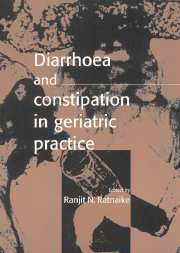Book contents
- Frontmatter
- Contents
- List of contributors
- Preface
- Acknowledgments
- Foreword by Gary R. Andrews
- I Defences of the aging gastrointestinal tract
- II Diarrhoea
- III Noninfectious clinical entities
- 11 Coeliac disease
- 12 Inflammatory disorders of the colon
- 13 Neoplasia and diarrhoea
- 14 Irritable bowel syndrome
- 15 Endocrine, metabolic and miscellaneous causes of diarrhoea
- IV Constipation
- V Perspectives of altered bowel function
- Index
11 - Coeliac disease
Published online by Cambridge University Press: 17 August 2009
- Frontmatter
- Contents
- List of contributors
- Preface
- Acknowledgments
- Foreword by Gary R. Andrews
- I Defences of the aging gastrointestinal tract
- II Diarrhoea
- III Noninfectious clinical entities
- 11 Coeliac disease
- 12 Inflammatory disorders of the colon
- 13 Neoplasia and diarrhoea
- 14 Irritable bowel syndrome
- 15 Endocrine, metabolic and miscellaneous causes of diarrhoea
- IV Constipation
- V Perspectives of altered bowel function
- Index
Summary
Introduction
It is not uncommon for coeliac disease to be diagnosed in elderly persons. Coeliac disease (synonyms: coeliac sprue, gluten-sensitive enteropathy) is a hypersensitivity reaction of the small intestine to the protein components of wheat, barley and rye cereals, which are all related in the same taxonomic tribe. This results in small intestinal damage in genetically predisposed individuals. It is a life-long disorder although the symptoms and age of presentation are variable. Patients with coeliac disease may present either after weaning or as adults. Teenagers with coeliac disease may notice that their symptoms remit and therefore they tend to default from their gluten-free diet, although it is known that their small bowel biopsies remain abnormal during this period. This temporary improvement during teenage years seems to explain the bimodal presentation that presumably depends on ileal compensation.
Coeliac disease, even when asymptomatic, may predispose to malabsorption of nutrients, metabolic bone disease and subsequent bone fractures, particularly in females, as well as to neoplasms such as intestinal lymphoma and adenocarcinoma, and head and oesophageal carcinomas. A high index of suspicion needs to be maintained such as requesting a duodenal biopsy during endoscopy examination for iron deficiency anaemia in the elderly. Often recurrent iron deficiency in this age group is wrongly attributed to colonic angiodysplasia, or to drugs such as nonsteroidal anti-inflammatory agents or warfarin.
Coeliac disease usually affects the proximal two-thirds of the small intestine where most of the nutrients are absorbed, except vitamin B, in the ileum.
Information
- Type
- Chapter
- Information
- Diarrhoea and Constipation in Geriatric Practice , pp. 133 - 138Publisher: Cambridge University PressPrint publication year: 1999
